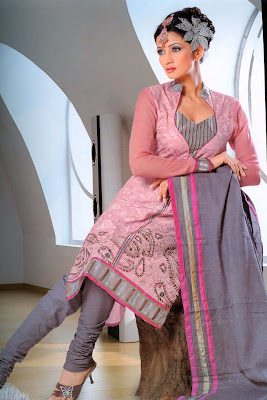Churidar Kameez Biography
Source (google.com.pk)huridars (Urdu: چُوڑی دار), (Punjabi: ਚੂੜੀਦਾਰ), or more properly churidar pyjamas (ਚੂੜੀਦਾਰ ਪਜਾਮਾ), are tightly fitting trousers worn by both men and women in South Asia. In Pakistan Churidar is most famous in people of North Indian Origin including Pakistani Punjabis and in people of Karachi who migrated from India in 1947. Churidars are a variant of the common salwar pants. Salwars are cut wide at the top and narrow at the ankle. Churidars narrow more quickly, so that contours of the leg are revealed. They are usually cut on the bias (at a 45-degree angle to the grain of the fabric) which makes them naturally stretchy. Stretch is important when pants are closefitting. They are also longer than the leg and sometimes finish with a tightly fitting buttoned cuff at the ankle. The excess length falls into folds and appears like a set of bangles resting on the ankle (hence 'churidar'; 'churi': bangle, 'dar': like). When the wearer is sitting, the extra material is the "ease" that makes it possible to bend the legs and sit comfortably. The word "churidar" is from Hindi and made its way into English only in the 20th century. Earlier, tight fitting churidar-like pants worn in India were referred to by the British as Moghul breeches, long-drawers, or mosquito drawers.
The churidar is usually worn with a kameez (tunic) by women or a kurta (a loose overshirt) by men, or they can form part of a bodice and skirt ensemble, as seen in the illustration of 19th century Indian women wearing churidar with a bodice and a transparent overskirt.
Kashmiri children." Full-length studio portrait of a young Kashmiri boy and girl, in the modern-day state of Jammu and Kashmir, taken by an unknown photographer in the 1890s. These elegantly dressed children are wearing clothing embroidered with intricate traditional patterns which are said to have been inspired by the beauty of the flora and fauna of Kashmir. This beautiful area on the northern borders of India and Pakistan is famous for its woollen textiles, fine shawls and carpets which are still produced using traditional methods going back centuries.
India is the birthplace of Hinduism, Buddhism, Jainism and Sikhism, collectively known as Indian religions. Indian religions, also known as Dharmic religions are a major form of world religions along with Abrahamic one. Today, Hinduism and Buddhism are the world's third and fourth-largest religions respectively, with over 2 billion followers altogether, and possibly as many as 2.5 or 2.6 billion followers.
India is one of the most religiously diverse nations in the world, with some of the most deeply religious societies and cultures. Religion still plays a central and definitive role in the life of many of its people.
According to a 2002 census of India, the religion of 80% of the people is Hinduism. Islam is practised by around 13% of all Indians. The country had over 23 million Christians, over 19 million Sikhs, about 8 million Buddhists and about 4 million Jains.
Sikhism, Jainism and especially Buddhism are influential not only in India but across the world. Christianity, Zoroastrianism, Judaism, and the Bahá'í Faith are also influential but their numbers are smaller. Atheism and agnostics also have visible influence in India, along with a self-ascribed tolerance to other people.
The Hindu religion has many schools, each with their own unique views. For example, according to Yogavasistha, a spiritual text of the Advaita school of Hindu religion, the values of the liberated (Hindi: जीवन्मुक्ति), self-actualized human being, may be summarized as "Pleasures do not delight him; pains do not distress. Although engaged in worldly actions, he has no attachment to any object. He is busy outwardly, yet calm inwardly. He feels free from restrictions of scriptures, customs, age, caste or creed. He is happy, but his happiness does not depend on anything else. He does not feel needy, proud, agitated, troubled, depressed or elated. He is full of compassion and forgiveness even to those who mean him harm. He does the right thing, regardless of the pressures. He is patient, perseverant, and without any impurity in his heart. He is free of delusions, he does not crave for anything. His sense of freedom comes from his spirit of inquiry. The fruits of his inquiry are his strength, intellect, efficiency and punctuality. He keeps company of wise and enlightened persons. He is content."
Churidar Kameez Designs for Men Women Girls 2013 Pakistani

Churidar Kameez Designs for Men Women Girls 2013 Pakistani
Churidar Kameez Designs for Men Women Girls 2013 Pakistani

Churidar Kameez Designs for Men Women Girls 2013 Pakistani

Churidar Kameez Designs for Men Women Girls 2013 Pakistani

Churidar Kameez Designs for Men Women Girls 2013 Pakistani
Churidar Kameez Designs for Men Women Girls 2013 Pakistani

Churidar Kameez Designs for Men Women Girls 2013 Pakistani

Anarkali salwar kameez is a traditional salwar kameez style among muslim women. They used to wear it along with dupatta which goes across neck and covers their head. This beautiful
ReplyDelete